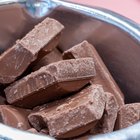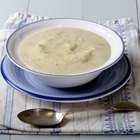srrdvd/iStock/GettyImages
Black licorice, a chewy candy with an anise flavor, has satisfied the sweet tooth of candy lovers for hundreds of years. Napoleon Bonaparte, emperor of France in the early 1800s, chewed licorice during battles. Rumor has it that he ate enough to turn his teeth black.
The licorice content in today's black licorice candy likely will not require a trip to the dentist for a whitening treatment, although your dentist may scold you for eating it; black licorice is high in sugar.
Calories and Fat
A five piece serving of black licorice contains from 100 to 140 calories. Based on a 2,000-calorie diet, this accounts for up to seven percent of the calories you may consume daily.
This candy does not provide a high degree of nutrition for the calories, so consider fruit instead, which will give you a sweet treat without the added sugar. The good news is that this candy contains very little fat — from zero to one gram per serving.
Carbohydrates and Protein
The carbohydrates in your diet primarily serve as energy for your body — they break down into glucose for that use. The type of carbohydrates in black licorice are likely to burn up quickly in your bloodstream, causing a spike in your blood sugar. This may result in an energy crash shortly after consumption.
A five piece portion of black licorice contains 22 to 31 grams of carbohydrates, or up to 23.8 percent of the 130 grams recommended for daily consumption by the Institute of Medicine. The institute also suggests including 46 to 56 gram of protein your daily meal plan. A serving of black licorice has one to two grams of this macronutrient.
Sugar
The sugar content in black licorice may create problems if you are intent on losing weight or are diabetic. A five piece serving of black licorice contains seven to 21 grams of sugar, the equivalent of over five teaspoons of granulated sugar.
The Cleveland Clinic recommends limiting your sugar intake to six to nine teaspoons per day. Not only does consuming too much sugar increase your risk of obesity, it raises your risk of developing diabetes, heart disease and high blood pressure. Enjoy black licorice in moderation as an occasional treat.
Sodium
Some brands of black licorice may contain high levels of sodium, which can present difficulties. The American Heart Association notes that consuming more than 1,500 milligrams of sodium regularly can increase your risk of health problems such as high blood pressure. A 40-g serving of black licorice contributes 40 to 180 milligrams of sodium to your daily totals.
Benefits
Pure licorice contains glycyrrhizic acid, which is extracted from the roots of the licorice plant. This sweet substance has found use in treating eye problems, hair loss and skin conditions for thousands of years. If the black licorice you eat contains adequate levels of glycyrrhizic acid, it may relieve symptoms associated with chest colds, too. It allegedly helps loosen phlegm and suppresses coughs.
Related Articles

Salt Water Taffy Nutritional Facts

Nutritional Value of Cooked Black Rice
Calories in a Jazz Apple

Nutrition Information on Blueberries

Is No Sugar Added Cranberry Juice Good ...

Calories in Cinnamon Toast

Are There Herbal Treatments for ...

The Calories in Black & White Cookies

Chocolate and Vitamins

Number of Calories in Dark ...

How to Clean Black Patent Leather Shoes

Menu for a Calorie-Restricted Diet

How Much Caffeine Is in Tootsie Rolls?
Keurig Coffee Nutrition

The Disadvantages of Saccharin

Potato Leek Soup Nutrition

How to Test Caffeine in Coffee

Asiago Cheese Nutrition

Does Benefiber Lower Cholesterol?

The Nutrition of 15-Bean Soup
References
Writer Bio
Nicki Wolf has been writing health and human interest articles since 1986. Her work has been published at various cooking and nutrition websites. Wolf has an extensive background in medical/nutrition writing and online content development in the nonprofit arena. She graduated with a Bachelor of Arts in English from Temple University.